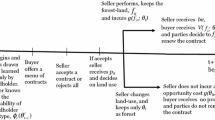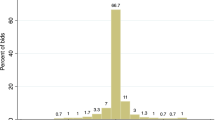Abstract
Payments for ecosystem service outputs have recently become a popular policy prescription for a range of agri-environmental schemes. The focus of this paper is on the choice of contract instruments to incentivise the provision of ecosystem service outputs from farms. The farmer is better informed than the regulator in terms of hidden information about costs and hidden-actions relating to effort. The results show that with perfect information, the regulator can contract equivalently on inputs or outputs. With hidden information, input-based contracts are more cost effective at reducing the informational rent related to adverse selection than output-based contracts. Mixed contracts are also cost-effective, especially where one input is not observable. Such contracts allow the regulator to target variables that are “costly-to-fake” as opposed to those prone to moral hazard such as effort. Further results are given for fixed price contracts and input-based contracts with moral hazard. The model is extended to include a discussion of repeated contracting and the scope that exists for the regulator to benefit from information revealed by the initial choice of contract. The models are applied to a case study of contracting with farmers to protect high biodiversity native vegetation that also provides socially-valuable ecosystem services.



Similar content being viewed by others
Notes
Types can be defined by a combination of productivity and behavioural parameters. Below we restrict attention to just two type models and only one type parameter distinguishing between firms.
The existence of this function is easily shown for the production function \(\hat{y}_i =\hat{x}_i^{b_1} e_i^{b_2 } \), rearranging effort is given by \(e_i (\hat{{x}}_i^ ,\hat{{y}}_i )=(\hat{{y}}_i /\hat{{x}}_i^{b_1 } )^{1/b_2 }\).
The exact distribution of transfers across the two periods can be varied by the regulator as long as the present-value of transfers is constant \(f_i^r \).
The IC and IR constraints are given for both periods together. Equivalently there could be separate constraints for each period, the solution is identical.
A more general semi-separating contract (Laffont and Tirole 1990) where the l-type randomly mixes between pooling and separating and the observation of the probability of mixing leads to a posterior probability of the types, is not analysed here because defining the optimal input levels is not tractable.
The Mathematica Notebook file used to derive results is available as additional material.
References
Anthon S, Garcia S, Stenger A (2010) Incentive contracts for Natura 2000 implementation in forest areas. Environ Resour Econ 46(3):281–302
Armsworth P, Acs S, Dallimer M, Gaston K, Hanley N, Wilson P (2012) The costs of simplification in conservation programmes. Ecol Lett 15(5):406–414
Balmford A, Green R, Phalan B (2012) What conservationists need to know about farming. Proc R Soc B Biol Sci 279(1739):2714–2724
Barbier EB (2013) Wealth accounting, ecological capital and ecosystem services. Environ Dev Econ 18(2):133–161
Baron DP (1985) Non-cooperative regulation of a non-localized externality. RAND J Econ 16(4):553–568
Bateman IJ, Mace GM, Fezzi C, Atkinson G, Turner K (2011) Economic analysis for ecosystem service assessments. Environ Resour Econ 48(2):177–218
Bolton P, Dewatripont M (2005) Contract theory. The MIT Press, Cambridge
Burton M, Zahedi J, White B (2012) Public preferences for timeliness and quality of mine site rehabilitation the case of bauxite mining in Western Australia. Resour Policy 37(1):1–9
Burton RJF, Schwarz G (2013) Result-oriented agri-environmental schemes in Europe and their potential for promoting behavioural change. Land Use Policy 30(1):628–641
Campbell HF, Bond KA (1997) The cost of public funds in Australia. Econ Rec 73(220):22–34
Derissen S, Quaas M (2013) Combining performance-based and action-based payments to provide environmental goods under uncertainty. Ecol Econ 85:77–84
European Court of Auditors (2011) Is agri-environment support well designed and managed? European Court of Auditors, Luxembourg
Ferraro PJ (2008) Asymmetric information and contract design for payments for environmental services. Ecol Econ 65:810–821
Gibbons JM, Nicholson E, Milner-Gulland EJ, Jones JPG (2011) Should payments for biodiversity conservation be based on actions of results? J Appl Ecol 48:1218–1226
Hanley N, Banerjee S, Lennox G, Armsworth P (2012) How should we incentivise private landowners to “produce” more biodiversity? Oxf Rev Econ Policy 28(1):93–113
Hart O, Moore J (1988) Incomplete contracts and renegotiation. Econometrica 56(4):755–785
Herzfeld T, Jongeneel RA (2012) Why do farmers behave as they do? Understanding compliance with rural, agricultural, and food attribute standards. Land Use Policy 29(1):250–260
Iossa E, Rey P (2014) Building reputation for contract renewal: implications for performance dynamics and contract duration. J Eur Econ Assoc 12(3):549–574
Khalil F, Lawarree J (1995) Input versus output monitoring: Who is the residual claimant? J Econ Theory 66(1):139–157
Kuhfuss L, Préget R, Thoyer S, Hanley N, Le Coent P, Désolé M (2015) Nudges, social norms and permanence in agri-environmental schemes. Discussion papers in environmental economics 2015/15, University of St Andrews
Laffont J-J, Martimort D (2002) The theory of incentives: the principal-agent model. Princeton University Press, Princeton
Laffont J-J, Tirole J (1988) The dynamics of incentive contracts. Econometrica 56(5):1153–1175
Laffont J-J, Tirole J (1990) Adverse selection and renegotiation in procurement. Rev Econ Stud 75:597–626
Laffont J-J, Tirole J (1993) A theory of incentives in procurement and regulation. MIT Press, Cambridge
Lau LJ (1976) Characterization of normalized restricted profit function. J Econ Theory 12(1):131–163
MacKenzie IA, Hanley N, Kornienko T (2008) The optimal initial allocation of pollution permits: a relative performance approach. Environ Resour Econ 39(3):265–282
Mäler K-G, Aniyar S, Jansson Å (2009) Accounting for ecosystems. Environ Resour Econ 42(1):39–51
Mas-Colell A, Whinston MD, Green JR (1995) Microeconomic theory. Oxford University Press, New York
Melkonyan T, Taylor M (2013) Regulatory design for agroecosystem management on public rangelands. Am J Agric Econ 95(3):606–627
Miteva D, Pattanayak S, Ferraro P (2012) Evaluation of biodiversity policy instruments. Oxf Rev Econ Policy 28(1):69–92
Moxey A, White B, Ozanne A (1999) Efficient contract design for agri-environment policy. J Agric Econ 50(2):187–202
Myers N, Mittermeier RA, Mittermeier CG, da Fonesca GAB, Kent J (2000) Biodiversity hotspots for conservation priorities. Nature 403(4):853–858
Ozanne A, White B (2007) Equivalence of input quotas and input charges under asymmetric information in agri-environmental schemes. J Agric Econ 58(2):260–268
Prober SM, Smith FP (2009) Enhancing biodiversity persistence in intensively used agricultural landscapes: a synthesis of 30 years of research in the Western Australian wheatbelt. Agric Ecosyst Environ 132(SI):173–191
Rey P, Salanie B (1990) Long-term, short-term and renegotiation—on the value of commitment in contracting. Econometrica 58(3):597–619
Rey P, Salanie B (1996) On the value of commitment with asymmetric information. Econometrica 64(6):1395–1413
Tirole J (1999) Incomplete contracts: where do we stand? Econometrica 67(4):741–81
Weitzman M (1974) Prices vs. Quantities. Rev Econ Stud 41(4):477–491
White B (2002) Designing voluntary agri-environmental policy with hidden information and hidden action. J Agric Econ 53(2):353–360
White B (2005) An economic analysis of ecological monitoring. Ecol Monit 189(1):241–251
White B, Sadler R (2012) Optimal conservation investment for a biodiversity-rich agricultural landscape. Aust J Agric Resour Econ 56(1):1–21
Wu JJ, Babcock BA (1996) Contract design for the purchase of environmental goods from agriculture. Am J Agric Econ 78(4):935–945
Zabel A, Roe B (2009) Optimal design of pro-conservation incentives. Ecol Econ 69(1):126–134
Author information
Authors and Affiliations
Corresponding author
Appendices
Appendix 1: Input-Based Contracts Asymmetric Information
The analysis of the theoretical model is greatly simplified by the fact that the IC for the l-type farm and the IR constraint for the h-type farm are the only constraints that are binding Following Laffont and Tirole (1993, p. 59) The incentive compatibility constraint for the low cost farmer (IC-l) is:
The individual rationality constraint for the h-type (IR-h) \(f_h -(c_e (\theta ^e ,e_h )+c_x (\theta _h^x ,x_h ))\ge 0\) implies:
As \(f_h \) is at least \((c_e (\theta ^e ,e_h )+c_x (\theta _h^x ,x_h ))\), Thus we can ignore the IR-l constraint as it is implied by IC-l
If we now optimize (15) with respect to IC-l and IR-h it is possible to check that IC-h is satisfied from the first order conditions (17) and (18), \(x_l >x_h \) and \(e_l >e_h \)
If we restate the IC-l constraint:
Where \(r_i\) is the rent The IC-h is:
Bringing the constraints together:
The assumption that the IC-h constraint is implied by the IR-h and IC-l constraints holds as long as \(c_x^{{\prime }{\prime }{\prime }} (\theta _i^x ,x_i )\ge 0\)
Appendix 2: Equivalency Between Mixed Contracts and Second-Best Input-Based Contracts
The regulator maximizes:
Subject to the participation for the high-cost type
and incentive compatibility constraint for the low cost type:
Both constraints enter as equalities. The four first order conditions for \(x_l , y_l , x_h , y_h \) are:
First we establish that the low cost farmer selects the first-best solution. Rearrange (47) to give:
and (47) to give:
Substituting for \(vg_{e_l }\):
This simplifies to:
Establishing that the solution is identical to the optimal solution to the input-based contract, on the basis of (49) effort is also identical.
The area and effort for the high cost farmer can also be shown to be the same as for the input-based contract. From (49) the last term is zero as the effort costs are identical and rearranging:
Rearranging (48) and substituting in (52) adding and subtracting \(\lambda c_x^{\prime } (\theta _h^x ,x_h )\) to the rhs and rearranging:
Using the fact that \(c_e^{\prime } (\theta ^{e},e(x_i ,y_i ))\hbox {e}_{x_h} -\phi _l c_e^{\prime } (\theta ^{e},e(x_i ,y_i ))\hbox {e}_{x_h} =\phi _h c_e^{\prime } (\theta ^{e},e(x_i ,y_i ))\hbox {e}_{x_h}\)
This simplifies to:
and this is identical to the first order condition for the input-based contract (18).
Rights and permissions
About this article
Cite this article
White, B., Hanley, N. Should We Pay for Ecosystem Service Outputs, Inputs or Both?. Environ Resource Econ 63, 765–787 (2016). https://doi.org/10.1007/s10640-016-0002-x
Accepted:
Published:
Issue Date:
DOI: https://doi.org/10.1007/s10640-016-0002-x




